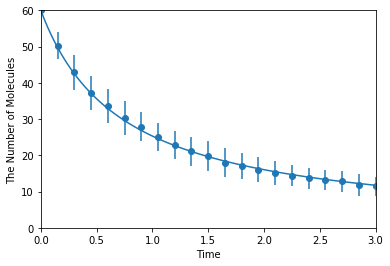See also
This page was generated from tests/Homodimerization_and_Annihilation.ipynb.
Download the Jupyter Notebook for this section: Homodimerization_and_Annihilation.ipynb. View in nbviewer.
Homodimerization and Annihilation¶
This is for an integrated test of E-Cell4. Here, we test homodimerization and annihilation.
[1]:
%matplotlib inline
from ecell4.prelude import *
Parameters are given as follows. D, radius, N_A, and ka_factor mean a diffusion constant, a radius of molecules, an initial number of molecules of A, and a ratio between an intrinsic association rate and collision rate defined as ka andkD below, respectively. Dimensions of length and time are assumed to be micro-meter and second.
[2]:
D = 1
radius = 0.005
N_A = 60
ka_factor = 0.1 # 0.1 is for reaction-limited
[3]:
N = 30 # a number of samples
Calculating optimal reaction rates. ka is intrinsic, kon is effective reaction rates. Be careful about the calculation of a effective rate for homo-dimerization. An intrinsic must be halved in the formula. This kind of parameter modification is not automatically done.
[4]:
import numpy
kD = 4 * numpy.pi * (radius * 2) * (D * 2)
ka = kD * ka_factor
kon = ka * kD / (ka + kD)
Start with A molecules, and simulate 3 seconds.
[5]:
y0 = {'A': N_A}
duration = 3
opt_kwargs = {'xlim': (0, duration), 'ylim': (0, N_A)}
Make a model with an effective rate. This model is for macroscopic simulation algorithms.
[6]:
with species_attributes():
A | {'radius': radius, 'D': D}
with reaction_rules():
A + A > ~A2 | kon * 0.5
m = get_model()
Save a result with ode as obs, and plot it:
[7]:
ret1 = run_simulation(duration, y0=y0, model=m)
ret1.plot(**opt_kwargs)
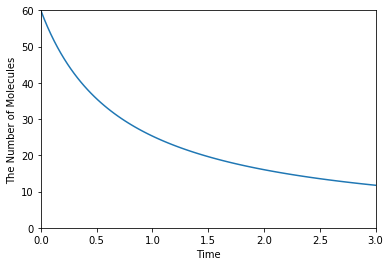
Simulating with gillespie:
[8]:
ret2 = ensemble_simulations(duration, ndiv=20, y0=y0, model=m, solver='gillespie', repeat=N)
ret2.plot('o', ret1, '-', **opt_kwargs)
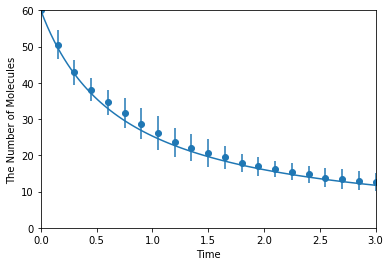
Simulating with meso:
[9]:
ret2 = ensemble_simulations(duration, ndiv=20, y0=y0, model=m, solver=('meso', Integer3(4, 4, 4)), repeat=N)
ret2.plot('o', ret1, '-', **opt_kwargs)
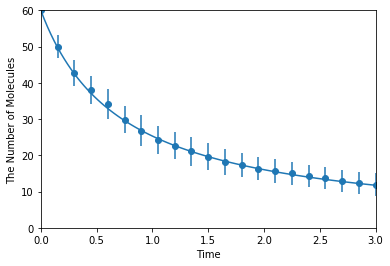
Make a model with an intrinsic rate. This model is for microscopic (particle) simulation algorithms.
[10]:
with species_attributes():
A | {'radius': radius, 'D': D}
with reaction_rules():
A + A > ~A2 | ka
m = get_model()
Simulating with spatiocyte:
[11]:
ret2 = ensemble_simulations(duration, ndiv=20, y0=y0, model=m, solver=('spatiocyte', radius), repeat=N)
ret2.plot('o', ret1, '-', **opt_kwargs)
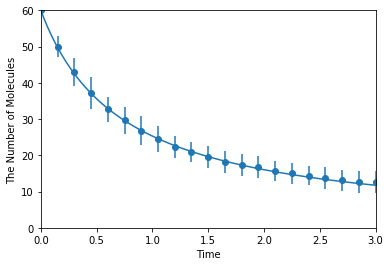
Simulating with egfrd:
[12]:
ret2 = ensemble_simulations(duration, ndiv=20, y0=y0, model=m, solver=('egfrd', Integer3(4, 4, 4)), repeat=N)
ret2.plot('o', ret1, '-', **opt_kwargs)
